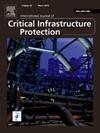SuPOR:用于物联网中机密性和抗攻击视觉数据安全的轻量级流密码
IF 5.3
3区 工程技术
Q1 COMPUTER SCIENCE, INFORMATION SYSTEMS
International Journal of Critical Infrastructure Protection
Pub Date : 2025-07-25
DOI:10.1016/j.ijcip.2025.100786
引用次数: 0
摘要
物联网(IoT)技术的快速发展,特别是相机和无人机等视觉传感器,导致包含个人身份信息(PII)的敏感视觉数据的传输增加。在存储和传输期间(例如,云或边缘服务器)保护这些数据对于维护隐私和安全至关重要。然而,由于计算开销和易受攻击,特别是在资源有限的物联网设备上,现有的加密方法经常面临挑战。为了弥补这一研究差距,本文提出了SuPOR,这是一种为物联网环境中的视觉数据保护量身定制的单轮轻量级密码。SuPOR框架包含五个基本的加密原则—替换、置换、异或、右循环移位和交换—它们按顺序执行。这些包括:(1)使用Möbius线性变换和伽罗瓦域构建安全的s盒进行像素级替换,(2)排列替换的像素以改善扩散,(3)应用加密安全伪随机数生成器(CSPRNG)为XORing生成64位一次性密钥,(4)在像素字节数组上执行正确的循环移位,以及(5)执行元素交换以进一步混淆数据。综合安全和统计评估表明,SuPOR在保持最小计算开销的同时,对各种攻击向量具有很强的抵抗力,线性时间复杂度为0 (nm+n(3×framesize))。实验比较表明,SuPOR超过了为物联网视觉数据设计的几种最先进的流密码,使其非常适合实时,资源受限的环境。研究结果为增强物联网系统中视觉数据的隐私和安全性提供了一种实用高效的解决方案,有效保护敏感信息免受威胁。本文章由计算机程序翻译,如有差异,请以英文原文为准。
SuPOR: A lightweight stream cipher for confidentiality and attack-resilient visual data security in IoT
The rapid growth of Internet of Things (IoT) technologies, particularly visual sensors such as cameras and drones, has resulted in increased transmission of sensitive visual data containing personally identifiable information (PII). Securing this data during storage and transmission (e.g., cloud or edge servers) is essential for maintaining privacy and security. However, existing encryption methods often face challenges due to computational overhead and vulnerability to attacks, especially on resource-limited IoT devices. To bridge this research gap, this paper presents SuPOR, a single-round lightweight cipher tailored for visual data protection in IoT environments. The SuPOR framework incorporates five fundamental cryptographic principles—Substitution, Permutation, XOR, right circular shift, and swap—which are executed in sequential steps. These include: (1) constructing a secure S-box using Möbius linear transformations and Galois fields for pixel-level substitution, (2) permuting the substituted pixels to improve diffusion, (3) applying a cryptographically secure pseudo-random number generator (CSPRNG) to generate a 64-bit one-time key for XORing, (4) performing right circular shifts on pixel byte arrays, and (5) executing element swaps to further obfuscate the data. Comprehensive security and statistical assessments demonstrate that SuPOR offers strong resistance against various attack vectors while maintaining minimal computational overhead, with a linear time complexity of . Experimental comparisons indicate that SuPOR surpasses several state-of-the-art stream ciphers designed for IoT visual data, making it highly suitable for real-time, resource-constrained environments. The findings provide a practical and efficient solution to enhance the privacy and security of visual data in IoT systems, effectively safeguarding sensitive information from threats.
求助全文
通过发布文献求助,成功后即可免费获取论文全文。
去求助
来源期刊

International Journal of Critical Infrastructure Protection
COMPUTER SCIENCE, INFORMATION SYSTEMS-ENGINEERING, MULTIDISCIPLINARY
CiteScore
8.90
自引率
5.60%
发文量
46
审稿时长
>12 weeks
期刊介绍:
The International Journal of Critical Infrastructure Protection (IJCIP) was launched in 2008, with the primary aim of publishing scholarly papers of the highest quality in all areas of critical infrastructure protection. Of particular interest are articles that weave science, technology, law and policy to craft sophisticated yet practical solutions for securing assets in the various critical infrastructure sectors. These critical infrastructure sectors include: information technology, telecommunications, energy, banking and finance, transportation systems, chemicals, critical manufacturing, agriculture and food, defense industrial base, public health and health care, national monuments and icons, drinking water and water treatment systems, commercial facilities, dams, emergency services, nuclear reactors, materials and waste, postal and shipping, and government facilities. Protecting and ensuring the continuity of operation of critical infrastructure assets are vital to national security, public health and safety, economic vitality, and societal wellbeing.
The scope of the journal includes, but is not limited to:
1. Analysis of security challenges that are unique or common to the various infrastructure sectors.
2. Identification of core security principles and techniques that can be applied to critical infrastructure protection.
3. Elucidation of the dependencies and interdependencies existing between infrastructure sectors and techniques for mitigating the devastating effects of cascading failures.
4. Creation of sophisticated, yet practical, solutions, for critical infrastructure protection that involve mathematical, scientific and engineering techniques, economic and social science methods, and/or legal and public policy constructs.
 求助内容:
求助内容: 应助结果提醒方式:
应助结果提醒方式:


